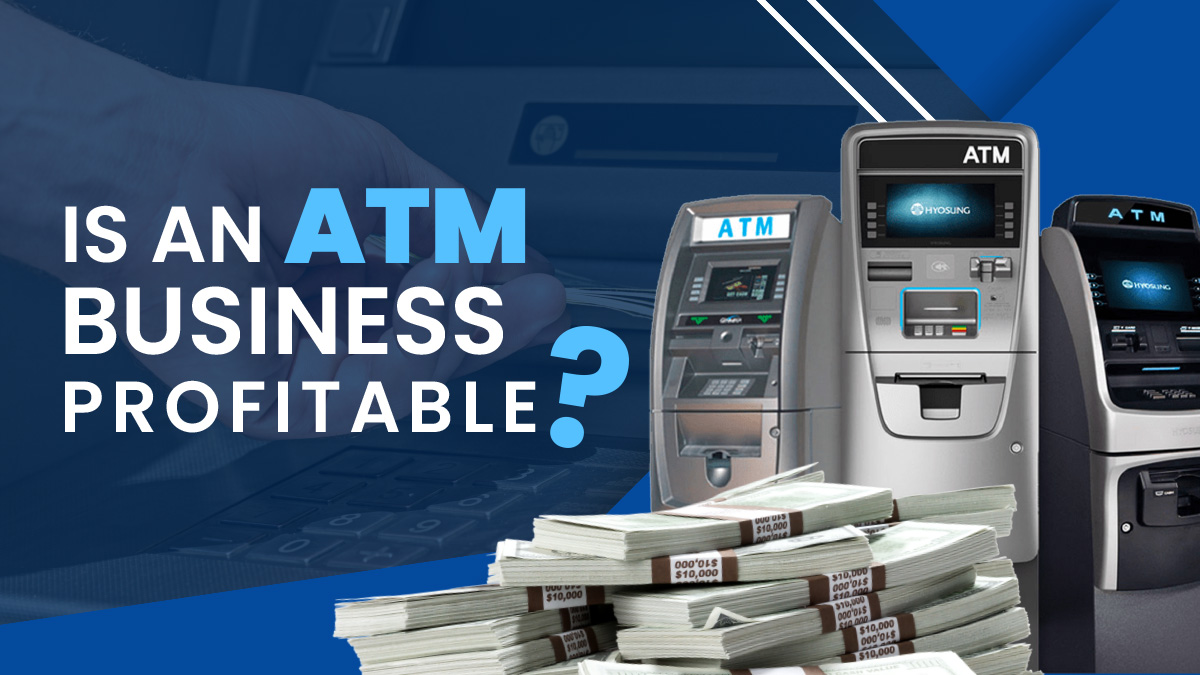In today’s fast-paced world, convenience is vital for businesses looking to attract and retain customers. One way to provide comfort and potentially increase revenue is by having an on-site automated teller machine (ATM). But is an ATM profitable for your business? This comprehensive guide will explore the ins and outs of owning an ATM, the potential income it can generate, and how to start and run a successful ATM business.
Benefits of Having an ATM
Before diving into the financial aspects of owning an ATM, let’s first explore the benefits it can bring to your business:
- Increased Revenue: With your establishment’s automated teller machine (ATM ), you can earn additional income through surcharge fees. Each time customers use the ATM, they pay a cost, and a portion of that fee goes to you as the ATM owner.
- Convenience for Customers: Offering an ATM on-site provides customers with easy access to cash. This convenience can attract more customers and encourage them to spend more at your business, as studies show that money withdrawn from an ATM in a retail business is often spent on the premises.
- Reduced Credit Card Processing Fees: By providing a cash option through an ATM, you can encourage customers to pay with cash rather than credit cards. This can help reduce credit card processing fees, saving you money in the long run.
- Potential for Additional Advertising Revenue: Some ATM operators generate additional income by placing advertisements on the ATM. This can be another source of revenue for your business.
Now that we understand the benefits, let’s explore the financial aspects of owning an ATM.
Potential Income from Owning an ATM Machine
The income potential of owning an ATM machine can vary based on several factors, including the location, surcharge fees, and the number of transactions. On average, ATM surcharge fees range from $2.50 to $3.00 per transaction. Assuming an average of 6 daily transactions, you could earn $15 to $18 daily, or $450 to $540 monthly, from a single ATM machine.
It’s important to note that these figures are just estimates, and the actual income can vary based on factors such as the number of transactions, the surcharge fee set, and the location of the ATM. Some high-traffic or specialized areas, such as casinos or concert venues, may even charge higher surcharge fees, leading to higher profits.
Choosing the right location for your ATM is crucial to maximize profits. Areas with high foot traffic, such as convenience stores, gas stations, bars, and tourist destinations, tend to have higher transaction volumes and can generate more income. Conducting thorough market research and identifying the demand for an ATM in a particular location can help increase the profitability of your ATM business.
Owning an ATM vs. ATM Placement
When considering an ATM for your business, you have two options: owning an ATM machine or opting for ATM placement. Let’s explore the pros and cons of each:
Owning an ATM Machine
Pros:
- You keep 100% of the surcharge fees (after ISO fees).
- You have complete control over the ATM, including the surcharge fee, maintenance, and cash management.
- There is potential for higher profits, especially in high-traffic locations.
- You will have flexibility in choosing the location and branding the ATM to align with your business.
Cons:
- There are higher upfront costs, including the purchase or lease of the ATM machine, installation fees, and cash stocking.
- There will be additional responsibilities, such as maintenance, cash management, and compliance with regulations.
- There are potential risks, such as vandalism or theft of the ATM machine.
ATM Placement
Pros:
- There are lower upfront costs, as the ATM owns the machine and handles installation and maintenance.
- There is little involvement in cash management and maintenance.
- There is potential for additional commission or revenue sharing from the ATM company.
Cons:
- You will have limited control over the ATM, including the surcharge fee and branding.
- There may be lower profit margins compared to owning an ATM machine.
- The ATM company will be reliant on maintenance and timely cash stocking.
Deciding between owning an ATM machine or opting for ATM placement depends on your specific circumstances, including your budget, level of involvement, and long-term goals for your ATM business.
Factors to Consider for a Profitable ATM Business
To ensure a profitable ATM business,
Several factors should be considered to run a good ATM business
Location
Choosing the right location is crucial for the success of your ATM business. Look for areas with high foot traffic and limited competition. Convenience stores, gas stations, bars, casinos, and retail stores are popular locations for ATMs. Conduct market research to identify potential sites and negotiate favorable terms with the property owners.
Expenses
Consider the expenses associated with owning an ATM, including the purchase or lease costs, installation fees, cash stocking, maintenance, and insurance. Calculate these costs carefully to determine the profitability of your ATM business. Staying updated with regulatory requirements and compliance is essential to avoid penalties.
Marketing and Branding
Promote your ATM business to attract customers. Utilize digital marketing strategies, such as social media, online directories, and local advertisements, to create awareness about your ATM and its convenience. Consider branding the ATM with your business logo and colors to create a cohesive customer experience.
Customer Service and Maintenance
Provide excellent customer service by ensuring your ATM is well-maintained and stocked with cash regularly. Promptly address any technical issues or concerns raised by customers. A well-maintained and reliable ATM will encourage repeat usage and build customer trust.
How to Start an ATM Business
Now that we’ve explored the profitability of owning an ATM and the factors to consider let’s discuss how to start an ATM business:
- Develop a Business Plan: Outline your business goals, target market, financial projections, and marketing strategies. This will serve as your roadmap for starting and growing your ATM business.
- Secure Financing: Determine the startup costs for your ATM business and explore financing options, such as loans or partnerships, to cover these expenses.
- Choose the Legal Structure: Decide on the legal structure of your ATM business, such as a sole proprietorship, partnership, or limited liability company (LLC). Consult with a legal professional to ensure compliance with local regulations.
- Obtain Necessary Licenses and Permits: Research and secure any required licenses and permits for operating an ATM business in your area. This may include business licenses, permits from local authorities, and compliance with financial regulations.
- Purchase or Lease ATM Machines: Select reliable and secure ATM machines from reputable manufacturers or suppliers. Consider features, durability, security measures, and maintenance support.
- Identify Profitable Locations: Conduct market research to identify high-traffic locations with a demand for ATMs. Approach businesses in these locations and negotiate mutually beneficial agreements for placing your ATMs.
- Install and Maintain ATMs: Install your ATMs in the selected locations and ensure regular maintenance, cash stocking, and technical support. Provide excellent customer service to both the business owners and ATM users.
- Market and Promote Your ATM Business: Utilize various marketing channels to create awareness about your ATM business. Leverage online platforms, print advertisements, and word-of-mouth referrals to attract customers to your ATMs.
- Monitor Performance and Adjust: Continuously monitor the performance of your ATMs, including transaction volumes, revenue, and customer feedback. Make necessary adjustments to maximize profitability and customer satisfaction.
Starting an ATM business requires careful planning, financial investment, and ongoing management. However, an ATM business can be profitable with the right strategies and a focus on customer convenience.
How profitable is it to start an atm business?
The profitability of an ATM business can vary widely based on factors like location, transaction volume, fees charged, and operational costs. Successful ATM businesses in high-traffic areas can generate significant profits, but it’s essential to conduct thorough market research and consider expenses like machine costs, maintenance, and cash stocking. Overall, with strategic placement and efficient management, an ATM business can be a profitable venture.
Is an ATM Business a Limited Liability Company?
An ATM business can be structured as a Limited Liability Company (LLC) to protect personal assets and limit liability. Forming an LLC offers legal protection while allowing flexibility in managing the business’s financial and operational aspects. Consulting legal and financial advisors can help determine the most suitable structure for an ATM business based on individual circumstances and goals.
What are profitable ATM Locations?
Profitable ATM locations often include high-traffic areas with consistent footfall and a need for cash access. These locations may include:
- Retail Centers: Malls, shopping centers, and retail stores generate consistent foot traffic.
- Entertainment Venues: Theaters, stadiums, amusement parks, and event venues attract crowds needing cash for tickets, food, and merchandise.
- Transportation Hubs: Airports, train stations, and bus terminals are ideal locations where travelers require cash for various expenses.
- Tourist Areas: Places with high foot traffic, such as famous landmarks, hotels, and tourist attractions.
- Urban Centers: Busy streets, downtown areas, and business districts with high population density and commercial activity.
- Convenience Stores/Gas Stations: Locations where people often need cash for small purchases or services.
Profitability can vary based on surcharge rates, transaction volumes, operational costs, and agreements with host locations. Conducting market research and analyzing foot traffic patterns can aid in identifying the most profitable ATM locations.
How many ATM Transactions does it take to generate a profit, and what is my target market?
The number of transactions needed to profit in an ATM business varies based on surcharge rates, operational costs, and transaction volumes. Typically, it’s not just the number of transactions but also the surcharge per transaction that contributes to profitability.
To determine your target market, consider locations with consistent foot traffic and a need for cash access. These may include retail centers, entertainment venues, transportation hubs, tourist areas, and urban centers. Analyzing potential users’ demographics and spending habits in these locations can help target the right audience for your ATMs.
How many convenience store customers will use my ATM vs at gas stations
The usage of ATMs in convenience stores versus gas stations can vary based on several factors. Convenience stores often witness more ATM transactions due to additional purchases, smaller transaction amounts, and varied customer needs. Gas stations typically see fewer ATM transactions, often tied to larger purchases like fuel.
However, this can differ based on the location, surrounding demographics, convenience stores or gas stations, foot traffic, and the attractiveness of your ATM services, including surcharge fees and accessibility. Conducting market research or analyzing existing ATM usage data in similar locations can provide insights into these usage patterns.
What ATM Services Can I Offer?
As an ATM business owner, you can offer various services beyond essential cash withdrawal, such as:
- Balance Inquiry: Allows users to check their account balance.
- Mini Statements: Provides a brief transaction history.
- Cash Withdrawals: The primary service allows users to withdraw cash.
- Fund Transfers: Some ATMs facilitate transfers between accounts.
- Bill Payments: Certain ATMs allow users to pay bills directly.
- Prepaid Services: Dispensing prepaid cards or mobile top-ups.
- Foreign Currency Exchange: In some locations or specialized ATMs.
The specific services available can depend on the ATM’s capabilities, your partnerships with banks or financial institutions, and the demand within the target market. Offering diverse services can attract more users and generate higher revenue.
Does More ATM Machines Create More Profit?
Having more ATM machines can potentially lead to increased profits, but it depends on various factors:
- Location: A prime factor determining profitability. High-traffic areas with a demand for cash services tend to generate more transactions and, therefore, more profit.
- Transaction Fees: Earning potential comes from transaction fees charged to users. More machines in strategic locations can mean more transactions and more expenses.
- Maintenance Costs: With more machines, maintenance costs, such as servicing, repairs, and replenishing cash, also increase.
- Competition: If you saturate a particular area with ATMs, it might reduce individual machine transactions due to increased user options.
While expanding your ATM network can potentially increase profits, carefully considering location, competition, and associated costs is vital to ensure profitability.
Is the ATM Industry a Profitable One?
The ATM industry can be profitable, but success depends on several factors:
- Location: The profitability of an ATM heavily relies on its placement. High-traffic areas with a demand for cash services tend to be more profitable.
- Transaction Volume: More transactions mean more revenue through transaction fees. Targeting locations with a high volume of cash users is crucial.
- Costs: Maintenance, cash stocking, and operational costs impact profitability. Efficient management of these expenses is essential.
- Competition: The level of competition in an area can affect transaction frequency and, consequently, profitability.
The ATM industry can be profitable with strategic placement, efficient operations, and effective cost management. However, success depends on careful planning and market analysis.
How Can I Make More Money Starting an ATM Business and How Much is General Liability Insurance?
To increase profitability in an ATM business:
- Location Selection: Opt for high-traffic areas with limited access to ATMs to maximize transactions and revenue.
- Transaction Fees: Strategically set transaction fees that are competitive yet profitable.
- Additional Services: Offer services like currency conversion, mobile top-ups, or bill payments to attract more users and increase transactions.
- Machine Uptime: Ensure regular maintenance to minimize downtime and maximize transaction opportunities.
Regarding general liability insurance, the cost can vary based on coverage limits, location, and the number of ATMs. It’s best to consult an insurance provider for an accurate quote tailored to your business needs and location.
What are the Initial Equipment Costs?
The initial equipment costs for ATM machines vary depending on the type of machine, features, and whether you purchase new or used units. New ATMs can range from $2,000 to $8,000 per machine, while used or refurbished units might cost between $1,000 and $5,000. Factors like security features, cash capacity, and additional functionalities can influence the price range. Additionally, installation, maintenance, and connectivity costs may be considered when setting up your ATMs.
How much can I make on a Business Credit Card withdrawal, and Do I need a Business Bank Account?
The earnings from business credit card withdrawals through an ATM can vary widely depending on transaction fees, surcharges, and agreements with the credit card issuer or bank. As an ATM owner, you typically earn a portion of the transaction fee for each withdrawal made through your machine. The exact amount can range from a few cents to a couple of dollars per transaction, depending on the agreement with the card issuer or bank.
Regarding whether you need a business bank account, having a separate account for an ATM business is highly recommended. It helps manage your finances, separate personal and business funds, and streamline your accounting processes. A dedicated business account also assists in tracking ATM-related income and expenses, ensuring financial clarity and ease of management.
Do I need an Internet Line for every ATM transaction, and can I do Money Transfers?
An internet connection is necessary for ATM transactions but only requires a dedicated line for each ATM. Typically, ATMs connect to a network via the Internet or phone lines to authorize transactions and communicate with the banking network.
Regarding money transfers, standard ATMs primarily dispense cash. However, some advanced ATMs or financial kiosks might offer additional services, including funds transfers between accounts or cash deposits. These functionalities often vary based on the ATM model and the services integrated into the network they’re connected to.
Why do I need an Independent ATM Deployer for My ATM Machine Business?
An Independent ATM Deployer (IAD) plays a crucial role in an ATM machine business for several reasons:
- Network Access: IADs have established relationships with ATM networks, which provide access to financial networks, transaction processing, and interbank connections. This access is essential for processing transactions and ensuring connectivity.
- Compliance and Regulations: IADs are well-versed in financial regulations, compliance standards, and industry-specific guidelines. They help ensure that your ATMs adhere to legal and industry standards.
- Technical Support: IADs offer technical expertise and support for your ATMs. They handle maintenance, software updates, troubleshooting, and repair services, ensuring your machines run smoothly.
- Transaction Processing: IADs facilitate transaction processing, including cash withdrawals, balance inquiries, and potentially other services, maximizing your machine’s functionality.
- Business Growth: Partnering with an IAD allows you to focus on the business aspects of ATM deployment, expanding your network and profit potential without being directly involved in the technical or regulatory details.
- Risk Management: IADs often manage risks associated with ATM operations, handling security measures, insurance, and fraud prevention to protect your business.
Overall, an IAD partnership streamlines ATM operations, ensuring compliance, providing technical support, and expanding your business reach while you concentrate on business growth and customer service.
How Much Do ATM Operators Charge for Repairs?
The cost of repairing ATM equipment can vary depending on the specific issue, the machine’s age, and the extent of the damage. Typically, repair costs include parts, labor, and any specialized technical expertise needed. It’s advisable to have a maintenance agreement with a reputable service provider or manufacturer, which can cover regular maintenance and some repair costs.
As for insurance coverage, an ATM business typically requires various types of insurance:
- General Liability Insurance covers bodily injury, property damage, and other liabilities from operating your ATM machines.
- Property Insurance: Protects against damage or loss to your ATMs due to theft, vandalism, fire, or natural disasters.
- Professional Liability Insurance: Also known as errors and omissions insurance, it covers claims related to professional mistakes, like incorrect transaction processing.
- Cyber Insurance: Given the sensitivity of financial data, this insurance covers losses due to cyberattacks, data breaches, or other cybersecurity threats.
- Business Interruption Insurance: Helps cover lost income or additional expenses if your ATM business operations are disrupted due to covered perils.
The cost of business insurance coverage for ATM businesses can vary significantly based on factors like location, coverage limits, deductible amounts, and the level of risk associated with your business. It’s advisable to consult an insurance broker or agent who specializes in business insurance to get quotes and recommendations tailored to your specific needs and circumstances.
What Do I Need to Own ATM Business?
Capital Investment
Starting an ATM business necessitates a significant capital investment covering various expenses such as purchasing or leasing ATM machines, finding suitable locations, installation costs, cash stocking, maintenance, insurance, and other operational expenses.
ATM Machines and Location Selection
Procuring reliable ATM machines, whether new or used, is a fundamental step. Identifying high-traffic, secure locations and establishing agreements with banks or ATM processors are essential to facilitate transactions and manage processing.
Regulatory Compliance and Insurance
Adhering to legal and regulatory requirements, obtaining necessary licenses and permits, and securing adequate insurance coverage are critical to ensure a smooth and compliant operation.
Technical Support and Maintenance
Accessing reliable technical support and maintenance services is crucial to ensure the continuous operation of ATM machines. Efficient cash management provides adequately funded machines, including loading, reconciliation, and monitoring.
Promotions and Business Plan
Promoting your ATMs to potential users and locations is pivotal to attracting customers. A comprehensive business plan outlining financial projections, marketing strategies, and operational plans is vital for success. Seeking advice from industry experts or associations can provide valuable guidance.
How much do I make from cash withdrawals?
The income from cash withdrawals via an ATM depends on various factors, including:
- Transaction Fees: As an ATM owner, you typically earn a portion of the transaction fee charged to the user. This fee varies and can range from a few cents to a few dollars per transaction.
- Surcharge: You might impose a surcharge fee, an additional charge levied on top of the user’s bank fee. This surcharge goes directly to the ATM owner.
- Location and Volume: Profitability can also be influenced by the location of your ATM and the number of transactions it processes. High-traffic areas often yield more transactions, hence higher earnings.
- Operating Costs: Keep in mind the operational costs, including machine maintenance, cash replenishment, and other overheads, as these impact the net income.
It’s essential to consider all these factors to estimate potential earnings accurately.
The profit from cash withdrawals in an ATM business varies based on several factors:
- Surcharge Fees: You earn a portion of the surcharge fee collected from each transaction. The exact amount depends on your agreement with the ATM processor or owner.
- Interchange Fees: You might receive a portion of the interchange fee paid between banks for using their networks.
The profit per transaction typically ranges from a few cents to several dollars, depending on the fees set, the number of transactions, and other operating costs associated with running the ATM.
What are the costs of starting an ATM Business, and what is a Business Strategy?
The costs of starting an ATM business can include:
- Machine Purchase or Lease: Acquiring the ATM involves purchasing or leasing machines. Prices vary based on the type, features, and whether new or used.
- Location Fees: Rent or fees for placing ATMs in specific locations.
- Installation and Maintenance: Costs for setting up the machines and ongoing maintenance.
- Cash Replenishment: Funds needed to stock the ATM with cash.
- Transaction Processing Fees: Charges incurred for each transaction processed through your ATM network.
A business strategy involves:
- Location Selection: Identifying high-traffic areas with potential customers.
- Network Partnerships: Establishing relationships with banks or networks for transactions.
- Marketing Plan: Promoting your ATMs to potential users and businesses.
- Service Quality: Ensuring smooth transactions, uptime, and responsive customer service.
- Financial Planning: Estimating revenue, expenses, and profitability to gauge the business’s potential success.
Considering these aspects, a solid ATM business plan is crucial for a successful ATM business.
Why start an ATM Business?
Starting an ATM business can be lucrative for several reasons:
- Passive Income: ATMs generate revenue through transaction fees, offering a passive income stream once operational.
- Demand: With cash still being widely used, ATMs remain in need, especially in locations with limited bank access.
- Low Operating Costs: Compared to many businesses, the ongoing operational costs of maintaining an ATM network are relatively low.
- Scalability: You can expand your ATM network gradually, adding more machines as you identify profitable locations.
- Flexibility: You can choose locations and adapt strategies based on changing market needs.
- Increased Foot Traffic: Placing ATMs in high-traffic areas can attract customers to businesses hosting your machines, potentially increasing sales.
However, conducting thorough research, considering startup costs, and developing a solid ATM business plan before venturing into the ATM business is essential.
>>Recommended Reading:127 Best Businesses to Start in 2024: An In-Depth Guide to Start Your Own Business<<
Bottom Line
Owning an ATM can be a profitable addition to your business or a standalone venture. By providing convenience to customers and generating additional income through surcharge fees, an ATM can contribute to your overall revenue. However, carefully considering location, expenses, and customer service is essential to ensure a successful and profitable ATM business. With thorough research, strategic planning, and diligent execution, you can capitalize on the opportunities offered by the growing ATM market and reap the benefits of owning an ATM.
 Sections of this topic
Sections of this topic
















